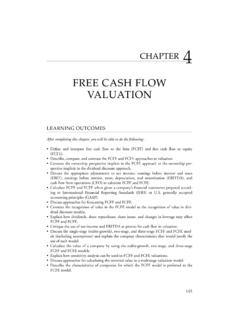Transcription of CAPITAL BUDGETING - Exam Success
1 CHAPTER. 2. CAPITAL BUDGETING . John D. Stowe, CFA. CFA Institute Charlottesville, Virginia Jacques R. Gagn , CFA. La Soci t de l'assurance automobile du Qu bec Quebec City, Canada LEARNING OUTCOMES. After completing this chapter, you will be able to do the following: Define the CAPITAL BUDGETING process, explain the administrative steps of the process, and categorize the CAPITAL projects that can be evaluated. Summarize and explain the principles of CAPITAL BUDGETING , including the choice of the proper cash flows and the identification of the proper discount rate. Explain how the following project interactions affect the evaluation of a CAPITAL project: (1) independent versus mutually exclusive projects, (2) project sequencing, and (3) unlim- ited funds versus CAPITAL rationing. Calculate and interpret the results produced by each of the following methods when evalu- ating a single CAPITAL project: net present value (NPV), internal rate of return (IRR), pay- back period, discounted payback period, average accounting rate of return (AAR), and profitability index (PI).
2 Explain the NPV profile, compare and contrast the NPV and IRR methods when evaluat- ing more than one CAPITAL project, and describe the multiple IRR and no IRR problems that can arise when calculating an IRR. Describe the relative popularity of the various CAPITAL BUDGETING methods and explain the effects of the NPV on a stock price. Compute the yearly cash flows of an expansion CAPITAL project and of a replacement CAPITAL project, and show how the depreciation method affects those cash flows. Discuss the effects of inflation on CAPITAL BUDGETING analysis. 47. 47 3/18/08 10:33:06 AM. 48 Corporate Finance Select the optimal CAPITAL project in situations of (1) mutually exclusive projects with unequal lives, using either the least common multiple of lives approach or the equivalent annual annuity approach, and (2) CAPITAL rationing. Explain how sensitivity analysis, scenario analysis, and Monte Carlo simulation can be used to estimate the standalone risk of a CAPITAL project.
3 Discuss the procedure for determining the discount rate to be used in valuing a CAPITAL project and illustrate the procedure based on the CAPM. Discuss the types of real options and evaluate the profitability of investments with real options. Describe several CAPITAL BUDGETING pitfalls. Calculate and interpret accounting income and economic income in the context of CAPITAL BUDGETING . Describe and contrast the following valuation models of a CAPITAL project: economic profit (EP), residual income, and claims valuation. 1. INTRODUCTION. CAPITAL BUDGETING is the process that companies use for decision making on CAPITAL projects . projects with a life of a year or more. This is a fundamental area of knowledge for financial analysts for many reasons. First, CAPITAL BUDGETING is very important for corporations. CAPITAL projects, which make up the long-term asset portion of the balance sheet, can be so large that sound CAPITAL budget- ing decisions ultimately decide the future of many corporations.
4 CAPITAL decisions cannot be reversed at a low cost, so mistakes are very costly. Indeed, the real CAPITAL investments of a company describe a company better than its working CAPITAL or CAPITAL structures, which are intangible and tend to be similar for many corporations. Second, the principles of CAPITAL BUDGETING have been adapted for many other corporate decisions, such as investments in working CAPITAL , leasing, mergers and acquisitions, and bond refunding. Third, the valuation principles used in CAPITAL BUDGETING are similar to the valuation prin- ciples used in security analysis and portfolio management. Many of the methods used by security analysts and portfolio managers are based on CAPITAL BUDGETING methods. Con- versely, there have been innovations in security analysis and portfolio management that have also been adapted to CAPITAL BUDGETING . Finally, although analysts have a vantage point outside the company, their interest in valu- ation coincides with the CAPITAL BUDGETING focus of maximizing shareholder value.
5 Because CAPITAL BUDGETING information is not ordinarily available outside the company, the analyst may attempt to estimate the process, within reason, at least for companies that are not too complex. Further, analysts may be able to appraise the quality of the company's CAPITAL BUDGETING process, for example, on the basis of whether the company has an accounting focus or an economic focus. This chapter is organized as follows: Section 2 presents the steps in a typical CAPITAL BUDGETING process. After introducing the basic principles of CAPITAL BUDGETING in Section 3, in Section 4 we discuss the criteria by which a decision to invest in a project may be made. 48 3/18/08 10:33:07 AM. Chapter 2 CAPITAL BUDGETING 49. Section 5 presents a crucial element of the CAPITAL BUDGETING process: organizing the cash flow information that is the raw material of the analysis. Section 6 looks further at cash flow analysis. Section 7 demonstrates methods to extend the basic investment criteria to address economic alternatives and risk.
6 Finally, Section 8 compares other income measures and valu- ation models that analysts use to the basic CAPITAL BUDGETING model. 2. THE CAPITAL BUDGETING PROCESS. The specific CAPITAL BUDGETING procedures that managers use depend on their level in the organization, the size and complexity of the project being evaluated, and the size of the orga- nization. The typical steps in the CAPITAL BUDGETING process are as follows: Step one, generating ideas: Investment ideas can come from anywhere, from the top or the bottom of the organization, from any department or functional area, or from outside the company. Generating good investment ideas to consider is the most important step in the process. Step two, analyzing individual proposals: This step involves gathering the information to forecast cash flows for each project and then evaluating the project's profitability. Step three, planning the CAPITAL budget: The company must organize the profitable proposals into a coordinated whole that fits within the company's overall strategies, and it also must consider the projects' timing.
7 Some projects that look good when considered in isolation may be undesirable strategically. Because of financial and real resource issues, scheduling and prioritizing projects are important. Step four, monitoring and postauditing: In a postaudit, actual results are compared to planned or predicted results, and any differences must be explained. For example, how do the revenues, expenses, and cash flows realized from an investment compare to the predictions? Postauditing CAPITAL projects is important for several reasons. First, it helps monitor the forecasts and analysis that underlie the CAPITAL BUDGETING process. Systematic errors, such as overly optimistic forecasts, become apparent. Second, it helps improve business operations. If sales or costs are out of line, it will focus attention on bringing performance closer to expectations if at all possible. Finally, monitoring and postauditing recent CAPITAL investments will produce concrete ideas for future investments.
8 Managers can decide to invest more heavily in profitable areas and scale down or cancel investments in areas that are disappointing. Planning for CAPITAL investments can be very complex, often involving many persons inside and outside the company. Information about marketing, science, engineering, regu- lation, taxation, finance, production, and behavioral issues must be systematically gathered and evaluated. The authority to make CAPITAL decisions depends on the size and complex- ity of the project. Lower-level managers may have discretion to make decisions that involve less than a given amount of money or that do not exceed a given CAPITAL budget. Larger and more complex decisions are reserved for top management, and some are so significant that the company's board of directors ultimately has the decision-making authority. Like everything else, CAPITAL BUDGETING is a cost benefit exercise. At the margin, the benefits from the improved decision making should exceed the costs of the CAPITAL BUDGETING efforts.
9 49 3/18/08 10:33:07 AM. 50 Corporate Finance Companies often put CAPITAL BUDGETING projects into rough categories for analysis. One such classification is as follows: 1. Replacement projects: These are among the easier CAPITAL BUDGETING decisions. If a piece of equipment breaks down or wears out, whether to replace it may not require careful analysis. If the expenditure is modest and if not investing has significant implications for production, operations, or sales, it would be a waste of resources to overanalyze the deci- sion. Just make the replacement. Other replacement decisions involve replacing existing equipment with newer, more efficient equipment or perhaps choosing one type of equip- ment over another. These replacement decisions are often amenable to very detailed analysis, and you might have a lot of confidence in the final decision. 2. Expansion projects: Instead of merely maintaining a company's existing business activi- ties, expansion projects increase the size of the business.
10 These expansion decisions may involve more uncertainties than replacement decisions, and they should be more care- fully considered. 3. New products and services: These investments expose the company to even more uncer- tainties than expansion projects. These decisions are more complex and will involve more people in the decision-making process. 4. Regulatory, safety, and environmental projects: These projects are frequently required by a governmental agency, an insurance company, or some other external party. They may generate no revenue and might not be undertaken by a company maximizing its own private interests. Often, the company will accept the required investment and continue to operate. Occasionally, however, the cost of the regulatory, safety, or environmental project is sufficiently high that the company would do better to cease operating alto- gether or to shut down any part of the business that is related to the project.




![arXiv:1802.05622v1 [stat.ML] 15 Feb 2018](/cache/preview/a/f/8/e/f/4/4/7/thumb-af8ef4477d04cde4c58b6f5e20086a5f.jpg)

